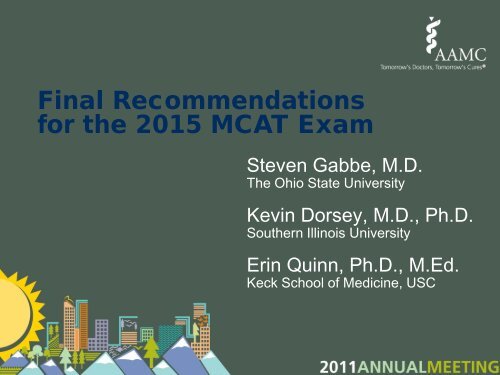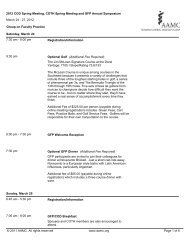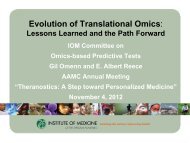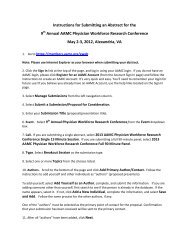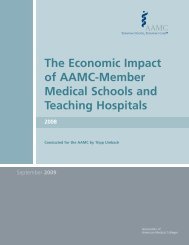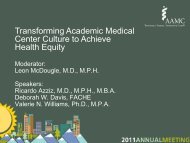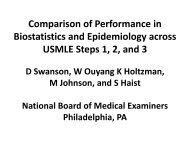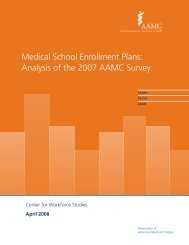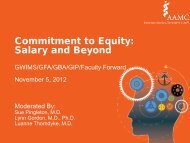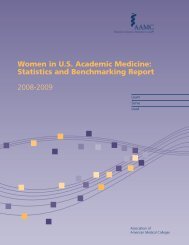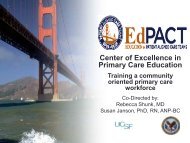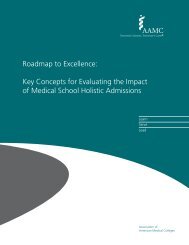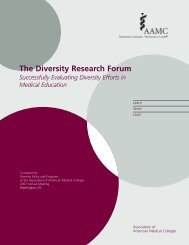Final Recommendations for the 2015 MCAT Exam - AAMC's ...
Final Recommendations for the 2015 MCAT Exam - AAMC's ...
Final Recommendations for the 2015 MCAT Exam - AAMC's ...
- No tags were found...
Create successful ePaper yourself
Turn your PDF publications into a flip-book with our unique Google optimized e-Paper software.
Why did we review <strong>the</strong> <strong>MCAT</strong> exam?• This is <strong>the</strong> fifth time <strong>MCAT</strong> was reviewed since itsfirst administration in 1928.• The current exam has been in use since 1991.• The new version of <strong>the</strong> test is likely to be in placethrough 2030—with a plan to refresh it midwaythrough so <strong>the</strong> exam keeps pace with changingscience.3
What did we accomplish?• Presented <strong>the</strong> preliminary recommendations toAAMC’s Board of Directors last February and <strong>the</strong>recommendations were favorably received• Released <strong>the</strong>m to <strong>the</strong> AAMC and pre-healthcommunities and press in March• Discussed <strong>the</strong>m in over 20 national, local, andtrade papers and in over 30 student newspapers• Presented <strong>the</strong>m at <strong>the</strong> spring GSA and NAAHPmeetings and at o<strong>the</strong>r meetings and conferencesthis spring and summer6
What are <strong>the</strong> next steps?• Previewed <strong>the</strong> final recommendations withrecipients of <strong>the</strong> MR5 e-newsletter last month• Have just a released a Preview Guide <strong>for</strong> <strong>the</strong>new exam, with detailed descriptions of <strong>the</strong>knowledge and skills <strong>the</strong> new exam will test,along with sample test questions• AAMC’s leadership will propose <strong>the</strong> future test toAAMC’s Board of Directors in February7
MR5 TimelineMR5committeeconvenesCommitteedeliberates,hosts 90outreach eventsInnovation labinvestigates personalcompetency measuresPreliminaryrecommendationsreleased <strong>for</strong>public comment<strong>Final</strong>recommendationsreleased atannual meeting<strong>Recommendations</strong>go to AAMC BOD<strong>for</strong> approvalNew examgoes live<strong>2015</strong>Fall 2008 Dec. 2009–Sept. 20102008-2011 March 2011November 2011Feb. 20128
What are our goals <strong>for</strong> <strong>the</strong> <strong>2015</strong><strong>MCAT</strong>?• Preserve what works best,• Eliminate what doesn’t, and• Enrich <strong>the</strong> exam by giving attention to conceptsthat future physicians are likely to need—usinga testing <strong>for</strong>mat that already has proven to besuccessful.9
What else are we recommending?• Resources that AAMC should provide toexaminees, pre-health advisors, and admissionsofficers to help <strong>the</strong>m prepare <strong>for</strong> <strong>the</strong> new exam• Work that AAMC should do that goes beyond <strong>the</strong>exam to develop new measures of integrity,service orientation, and o<strong>the</strong>r personalcharacteristics that admissions committees canuse early in student selection10
11What are our recommendationsabout <strong>the</strong> content and <strong>for</strong>mat of <strong>the</strong>new test?
Include 4 test sections and report 4scores, including <strong>the</strong>:• Biological and biochemical foundations of livingsystems• Chemical and physical foundations of biologicalsystems• Psychological, social, and biologicalfoundations of behavior• Critical analysis and reasoning skills12
Preserve what’s best:• Two natural science tests will be organizedaround concepts described by <strong>the</strong> SFFPcommittee as important to entering students’success• Reflect medical school faculty’s, residents’, andstudents’ ratings of <strong>the</strong> most important of <strong>the</strong>se• Will test examinees’ knowledge and use of <strong>the</strong>highly-rated concepts in biology, general andorganic chemistry, physics, biochemistry,cellular/molecular biology, research methods,and statistics13
Preserve what’s best:• At many schools, students currently learn <strong>the</strong>seconcepts in introductory biology, general andorganic chemistry, and physics, and in firstsemesterbiochemistry courses• Cellular/molecular biology concepts that will betested are taught in most introductory biologysequences• Research methods and statistics concepts thatwill be tested are foundational and described byundergraduate faculty as important to students’success in introductory science courses14
Preserve what’s best:• Questions on <strong>the</strong> two exams will ask examineesto combine <strong>the</strong>ir knowledge of natural sciencesconcepts with <strong>the</strong>ir scientific inquiry, reasoning,research methods and statistics skills to solveproblems that demonstrate readiness <strong>for</strong>medical schoolScientific inquiry, reasoning,research methods, andstatistics skillsNatural SciencesConceptsQuestions15
Preserve what’s best:• Critical analysis and reasoning section will testexaminees’ reasoning by asking <strong>the</strong>m to criticallyanalyze, evaluate, and apply in<strong>for</strong>mation providedby passages• Encourage examinees to read broadly and inhumanities and social sciences disciplines tofamiliarize <strong>the</strong>mselves with <strong>the</strong> issues <strong>the</strong>y raise• Will include passages from ethics and philosophy,cross-cultural studies, population health, and a widerange of social sciences and humanities disciplines• Questions won’t require disciplinary knowledge--allneeded in<strong>for</strong>mation will appear in <strong>the</strong> passages16
Eliminate what’s not:• Drop <strong>the</strong> Writing Sample section because:• Data show that most admissions committeesuse WS scores <strong>for</strong> relatively few applicants,and• Though WS scores and medical studentoutcomes have small positive correlations,WS has little incremental predictive valueover UGPA and VR scores.17
Enrich <strong>the</strong> exam:• Psychological, social, and biological foundationsof behavior section will test knowledge and useof concepts that provide a solid foundation <strong>for</strong>learning in medical school about <strong>the</strong> behavioraland socio-cultural determinants of health andhealth outcomes• Organized around concepts described by <strong>the</strong>Behavioral and Social Sciences Foundations <strong>for</strong>Future Physicians Committee as important tomedical students’ success18
Enrich <strong>the</strong> exam:The new section will test:• Ways in which psychological, social, andbiological factors influence our perceptions andreactions to <strong>the</strong> world• Behavior and behavior change• What we think about ourselves and o<strong>the</strong>rs• Cultural and social differences that influencewell-being• Relationships between social stratification,access to resources, and well-being19
Enrich <strong>the</strong> exam:• At many schools, students currently learn <strong>the</strong>seconcepts in first-semester psychology andsociology (and in introductory biology)• Questions will ask examinees to combine <strong>the</strong>irknowledge of <strong>the</strong>se concepts with <strong>the</strong>ir scientificinquiry, reasoning, research methods andstatistics skills to solve problems thatdemonstrate readiness <strong>for</strong> medical schoolSocial and BehavioralSciences ConceptsScientific inquiry, reasoning,research methods, andstatistics skillsQuestions20
Additionally, we recommend:• Introduce <strong>the</strong> new exam in <strong>2015</strong>• Report scores on a scale that’s similar to <strong>the</strong>current 1-15 scale, ra<strong>the</strong>r than on a pass/ fail oro<strong>the</strong>r categorical scale• Report scores with confidence bands around<strong>the</strong>m so users are reminded of <strong>the</strong> errorassociated with applicants’ scores• Update <strong>the</strong> content that <strong>the</strong> exam tests on aregular schedule to ensure that <strong>MCAT</strong> keepspace with <strong>the</strong> rapid changes in science21
22What are our recommendationsabout <strong>the</strong> resources AAMC shouldprovide to examinees, pre-healthfaculty, and admissions committees<strong>for</strong> <strong>the</strong> new exam?
Resources <strong>for</strong> admission officers:• Webinars, guides and o<strong>the</strong>r resources thatclearly describe <strong>the</strong> new exam and <strong>the</strong> types ofdecisions test scores are and are not designedto support in a holistic review of applicants’qualifications• A new Validity Studies Service to help medicalschools track data and conduct research on <strong>the</strong>value and validity of <strong>the</strong> new exam <strong>for</strong> studentselection at <strong>the</strong>ir schools23
Resources <strong>for</strong> prospectiveexaminees:• Preview Guide <strong>for</strong> <strong>MCAT</strong> <strong>2015</strong>• detailed descriptions <strong>for</strong> all 4 sections,including knowledge and skills tested• detailed topic lists• sample test questions• www.aamc.org/mcat<strong>2015</strong>/preview.pdf• Videos describing <strong>MCAT</strong> <strong>2015</strong> and preparation• Dedicated web site: www.aamc.org/mcat<strong>2015</strong>• The Official Guide to <strong>MCAT</strong> <strong>2015</strong> by 2014• Free full-length practice test online by 201424
Financial support <strong>for</strong> examinees:• Low-cost and free preparation materials• Fee Assistance Program includes <strong>MCAT</strong>:• Reduced fee <strong>for</strong> <strong>MCAT</strong>• Free copy of The Official Guide to <strong>MCAT</strong> <strong>2015</strong>• <strong>Exam</strong>inees with special needs have access to$500 scholarships <strong>for</strong> <strong>the</strong> costs of evaluationsthat <strong>the</strong>y need to apply <strong>for</strong> testingaccommodations25
Reaching ALL students:• Special attention to <strong>the</strong> educational needs ofstudents at under-resourced institutions:• Student organizations and fairs• ‘Boots-on-<strong>the</strong>-ground’ support from medicalstudents, admissions staff, and diversityofficers• Support to <strong>the</strong>ir advisors and faculty• Continuing work on outreach strategies <strong>for</strong>educationally- and economically-disadvantagedstudents26
Resources <strong>for</strong> advisors and o<strong>the</strong>rfaculty:• Preview Guide <strong>for</strong> <strong>MCAT</strong> <strong>2015</strong> – detailedexplanations of concepts, topic lists, and samplequestions• Advisor section of web site:www.aamc.org/mcat<strong>2015</strong>• Webinars and conference presentations• Complimentary copies of The Official Guide to<strong>MCAT</strong> <strong>2015</strong>• Discounts on bulk orders of preparation materials,including practice tests <strong>for</strong> <strong>MCAT</strong> <strong>2015</strong>27
Resources <strong>for</strong> advisors and o<strong>the</strong>rfaculty:• PreHealthCollaborative curriculum-sharingproject to encourage innovation• Online repository of instructional modules <strong>for</strong>concepts that entering medical students needto know• Cataloged by concept• User comments feature to support use• Makes it easier to adopt innovative contentand methods in existing courses28
Resources <strong>for</strong> advisors and o<strong>the</strong>rfaculty:• Special attention to under-resourced institutionsthrough:• Direct outreach, especially to advisors andfaculty at minority-serving schools• Conferences and professional organizations• ‘Boots-on-<strong>the</strong>-ground’ support from medicalstudents, admissions staff, and diversityofficers29
30What are our recommendations <strong>for</strong>helping medical schools considerdata on integrity, serviceorientation, and o<strong>the</strong>r personalcharacteristics early in studentselection?
Go beyond <strong>the</strong> <strong>MCAT</strong> exam to:Investigate options <strong>for</strong> ga<strong>the</strong>ring data aboutpersonal characteristics through:• A new section of <strong>the</strong> AMCAS application thatasks applicants to reflect on experiences thatdemonstrate <strong>the</strong>ir personal characteristics, and• Standardized letters that ask recommenders torate and write about behaviors that demonstrateapplicants’ personal and academiccharacteristics.31
Go beyond <strong>the</strong> <strong>MCAT</strong> exam to:• Mount a rigorous program of research on <strong>the</strong>extent to which applicants’ personalcharacteristics might be measured:• As part of a separate regional or nationalevent, or• Locally by admissions committees usingnationally-developed tools.• We’ll hear more about <strong>the</strong>se recommendationsnext.32
33What are <strong>the</strong> reasons <strong>for</strong> ourrecommendations?
What are <strong>the</strong> reasons <strong>for</strong> ourrecommendations?• Using a testing <strong>for</strong>mat that has provensuccessful, our recommendations preserve whatworks, eliminate what isn’t working and, byattending to concepts that future physicians arelikely to need, fur<strong>the</strong>r enrich <strong>the</strong> exam.• They balance testing between <strong>the</strong> naturalsciences, <strong>the</strong> social and behavioral sciences,and critical analysis and reasoning.• They respond to <strong>the</strong> SFFP and BSSFFPrecommendations and reflect current science.34
What are <strong>the</strong> reasons <strong>for</strong> ourrecommendations?• They ask examinees to demonstrate <strong>the</strong>irknowledge of <strong>the</strong> natural, social, and behavioralsciences by solving problems that call <strong>for</strong>scientific thinking, research, and statistics skills.• They communicate <strong>the</strong> need <strong>for</strong> students whoare prepared to deal with <strong>the</strong> human and socialissues of medicine, and <strong>the</strong>y stress <strong>the</strong> necessityof reading broadly to prepare <strong>for</strong> medical school.35
36Questions?
MR5 Committee MembersSteven G. Gabbe, M.D. (Chair)Sr. Vice President <strong>for</strong> Health SciencesCEO, The OSU Medical CenterThe Ohio State UniversityCollege of MedicineRonald D. Franks, M.D. (Vice Chair)VP, Health SciencesUniversity of South AlabamaHealth Sciences DivisionRobert Hilborn, Ph.D.Associate Executive OfficerAmerican Association of Physics Teachers( <strong>for</strong>merly, University of Texas at Dallas)Barry A. Hong, Ph.D., M.DIV.Professor of Psychiatryand MedicineWashington University in St. LouisSchool of MedicineLisa T. Alty, Ph.D.Professor and Head, Dept. of ChemistryWashington and Lee UniversityDwight Davis, M.D.Associate Dean <strong>for</strong> Admissions & Student AffairsPennsylvania State UniversityCollege of MedicineJ. Kevin Dorsey, M.D., Ph.D.Dean and ProvostSIU School of MedicineMichael J. Friedlander, Ph.D.Founding Executive DirectorVirginia Tech Carilion Research InstituteRichard Lewis, Ph.D.Prof. of Psychology and NeurosciencePomona CollegeMaria F. Lima, Ph.D.Dean, School of Graduate StudiesMeharry Medical CollegeCa<strong>the</strong>rine R. Lucey, M.D.Vice Dean <strong>for</strong> EducationUCSF School of MedicineAlicia Monroe, M.D.Vice Dean, Educational AffairsUniversity of South FloridaCollege of Medicine37
MR5 Committee MembersSaundra H. Oyewole, Ph.D.Professor and Chair of BiologyTrinity Washington UniversityRichard M. Schwartzstein, M.D.Professor of MedicineBeth Israel Deaconess Medical CenterErin A. Quinn, Ph.D., M.Ed.Associate Dean of Admissions EmeritusCo-Director, Primary Care Community Medicine ProgramKeck School of Medicine University of Sou<strong>the</strong>rn Cali<strong>for</strong>niaRichard K. Riegelman, M.D., Ph.D.Professor of EpidemiologyBiostatistics, Medicine and Health PolicyFounding DeanThe George Washington UniversitySchool of Public Health and Health ServicesGary C. Rosenfeld, Ph.D.Professor, Integrative Biology andPharmacologyUniversity of Texas Medical Schoolat HoustonWayne M. Samuelson, M.D.Associate Dean of AdmissionsUniversity of Utah School of MedicineMaureen Shandling, M.D.Senior Vice President, MedicalMount Sinai HospitalAssociate Professor, Division of NeurologyFaculty of Medicine, University of TorontoMs. Ca<strong>the</strong>rine SpinaBoston University School of MedicineMD/PhD CandidateExpected Graduation <strong>2015</strong>Ricci Sylla, M.D.PGY-1 Ob/GynKaiser Permanente Santa ClaraJames W/ Pellegrino, Ph.D. (Committee Consultant)Psychology and EducationUniversity of Illinois, ChicagoPaul R. Sackett, Ph. D. (Committee Consultant)Industrial/Organizational PsychologistUniversity of Minnesota38
Innovation Lab Working Group MembersThomas W. Koenig, M.D.Associate Dean <strong>for</strong> Student AffairsJohns Hopkins UniversitySchool of MedicineJoy P. WilliamsAssociate Dean <strong>for</strong> Students and Special ProgramsGeorgetown UniversitySchool of MedicineSamuel K. Parrish, M.D.Senior Associate Dean <strong>for</strong> Student Affairs and AdmissionsDrexel UniversityCollege of MedicineMR5 StaffKaren Mitchell, Ph.D., <strong>MCAT</strong> Senior DirectorScott Oppler, Ph.D., Director, <strong>MCAT</strong> Development andPsychometricsDana Dunleavy, Ph.D., Manager, Admissions ResearchDawn Zhao, Ph.D., <strong>MCAT</strong> Senior Measurement ResearchAnalystCarol Terregino, M.D.Associate Dean <strong>for</strong> AdmissionsChair, Admissions CommitteeUniversity of Medicine and Dentistry of New JerseyRobert Wood Johnson Medical SchoolMarc Kroopnick, Ph.D., <strong>MCAT</strong> Senior MeasurementResearch AnalystJoseph Volsch, M.P.A., <strong>MCAT</strong> Research SpecialistKeith Dowd, M.S., <strong>MCAT</strong> Measurement Research Analyst39
Includes 4 test sections and reports4 scores:• Section scores will have greater accuracy and bemore interpretable than current section scores• Sections will include more test questions and belonger than <strong>the</strong> current sections• This will leng<strong>the</strong>n <strong>the</strong> testing day from about <strong>the</strong>current 5½ hours to about 7½ hours (with time<strong>for</strong> administrative issues, breaks, and lunch)40
Includes 4 test sections and reports4 scores:• New biochemistry, psychology, and sociologycontent will call <strong>for</strong> additional study• At many schools, students currently learn <strong>the</strong>seconcepts in first-semester biochemistry,psychology, and sociology courses• Without in<strong>for</strong>mation about <strong>the</strong> new test, aquarter of current applicants take all three of<strong>the</strong>se courses, 40% take two, 30% take one,and 5% take none41
What are <strong>the</strong> next implementationsteps?• Refine blueprints <strong>for</strong> item writing and testconstruction• Conduct small-scale studies of possible groupdifferences on new content• Field test new content in 2013 and 2014• Stop administering <strong>the</strong> Writing Sample in 2013and use <strong>the</strong> last hour of <strong>the</strong> operational test tocollect field-test data from examinees whovolunteer42
Frequently Asked Questions (FAQs) About Fairness andBias1. Is <strong>the</strong> <strong>MCAT</strong> fair and unbiased?Yes. AAMC follows rigorous test development and validation procedures to insure that <strong>the</strong> <strong>MCAT</strong> isnot biased.First, every item on <strong>the</strong> <strong>MCAT</strong> is reviewed to ensure that it does not contain content or language thatwould be offensive to some groups or that would have different meaning in different cultures.Second, item statistics are examined <strong>for</strong> every operational <strong>MCAT</strong> item to ensure that it functions asintended <strong>for</strong> various groups.Third, research studies are conducted to verify that <strong>MCAT</strong> scores do not underestimate <strong>the</strong>subsequent medical school per<strong>for</strong>mance of students from racial/ethnic minority groups.2. Do members of some groups score lower on <strong>the</strong> <strong>MCAT</strong> than o<strong>the</strong>rs?Yes. Average (mean) scores of White and Asian test-takers are higher than those <strong>for</strong> Black, Hispanic,and Native American test-takers.(in standard deviation terms, <strong>the</strong> White-Black difference is 1.05 SD, <strong>the</strong> White-Hispanic difference is.78, <strong>the</strong> White-Asian difference is .03, and White-Native American difference is .052. The <strong>MCAT</strong> totalscore standard deviation is 6.4, so, <strong>for</strong> example, <strong>the</strong> White-Black difference is about 6.7 points on ascale ranging from 3 to 45.)It’s important to note that test-takers from all groups exhibit <strong>the</strong> full range of scores, from very high tovery low. A difference in average scores does not mean that all members of one group obtain highscores or that all members of <strong>the</strong> o<strong>the</strong>r group obtain low scores.43
Frequently Asked Questions (FAQs) About Fairness andBias3. Doesn’t a finding of differences in mean scores indicate that <strong>the</strong> <strong>MCAT</strong> is biased?No. As professional testing standards note, mean differences alone don’t permit a judgment as towhe<strong>the</strong>r a test is or is not biased.For example, a test of empathy that results in higher mean scores <strong>for</strong> women than men might mean<strong>the</strong> test is biased, or it might accurately indicate that in this group of test takers women really are, onaverage, more empa<strong>the</strong>tic.Thus when we observe mean differences, we need to examine whe<strong>the</strong>r test scores accuratelydescribe test-takers’ current level of <strong>the</strong> characteristic being assessed. The AAMC conductsextensive research to ensure that <strong>the</strong> <strong>MCAT</strong> measures <strong>the</strong> skills of interest, ra<strong>the</strong>r than is not biased(see FAQ #1 above).4. Does <strong>the</strong> <strong>MCAT</strong> show larger group mean group differences than o<strong>the</strong>r admissions tests?No. Differences on <strong>the</strong> <strong>MCAT</strong> parallel those on undergraduate, graduate, and professional schooladmissions tests. Thus <strong>the</strong>re is nothing unique about <strong>the</strong> <strong>MCAT</strong> in this regard.44
Frequently Asked Questions (FAQs) About Fairness andBias5. What is <strong>the</strong> cause of <strong>the</strong> mean differences on <strong>the</strong> <strong>MCAT</strong>?Research has identified a large number of risk factors linked to lower academic achievement. Exposure tomany of <strong>the</strong>se risk factors is higher <strong>for</strong> Black and Hispanic students than <strong>for</strong> White students. While thisresearch is on broad samples of <strong>the</strong> population, ra<strong>the</strong>r than on medical school applicants, we believe itoffers important insights.These include risk factors in various categories, including:Family (e.g., lack of parental participation at school; frequency of moving and changing schools)Environmental (e.g., lead exposure in early childhood)Neighborhood (e.g., living in high poverty neighborhoods)School (e.g., changing teachers in mid-year; fear and safety concerns at school)Thus we do not believe that <strong>the</strong>re is one single determinant of <strong>the</strong> mean difference in <strong>MCAT</strong> scores acrossgroups. Ra<strong>the</strong>r, many factors contribute, and it is likely that we have yet to identify <strong>the</strong> full set of factors.6. Does stereotype threat bias scores on <strong>the</strong> <strong>MCAT</strong>?Many laboratory research studies show that making race or gender salient to test-takers can affect <strong>the</strong> testper<strong>for</strong>mance of members of stereotyped groups.However, <strong>the</strong>re is very little research examining stereotype threat in operational high-stakes testing settings.Research in such settings often does not find evidence of threat effects.We do not see evidence of systematic stereotype threat effects on <strong>the</strong> <strong>MCAT</strong>. If scores of stereotypedgroup members are lowered due to threat, <strong>the</strong>n <strong>MCAT</strong> should underestimate <strong>the</strong> subsequent medical schoolper<strong>for</strong>mance of students from <strong>the</strong>se stereotyped groups. However, as noted in FAQ#1, <strong>MCAT</strong> researchdoes not find such underestimation.45
Frequently Asked Questions (FAQs) About Fairness andBias7. Since <strong>the</strong>re are mean differences between groups on <strong>the</strong> <strong>MCAT</strong>, why not drop <strong>the</strong> <strong>MCAT</strong>and rely on college grades instead?College grades show mean differences between groups similar to <strong>the</strong> differences on <strong>the</strong> <strong>MCAT</strong>. Soreplacing <strong>MCAT</strong> with grades would not be a way to eliminate group differences.Medical schools do indeed give considerable attention to grades, in addition to <strong>MCAT</strong> scores ando<strong>the</strong>r factors. It is a misconception that <strong>MCAT</strong> scores alone drive admissions decisions.Grade point average reflects differing patterns of course-taking across students, different levels ofcourse difficulty across institutions, and differences in instructor grading standards. In contrast, <strong>the</strong><strong>MCAT</strong> offers a common basis <strong>for</strong> comparison across all applicants.8. Do mean differences serve as a barrier to admission <strong>for</strong> groups with lower mean scores?No. Medical school admission relies on a holistic integration of multiple factors, not just <strong>the</strong> <strong>MCAT</strong>,and admission rates are similar across groups.(detail: proportions admitted by group are White: 46%; Black: 39%; Hispanic: 46%; Asian: 42%;Native American: 44%.)If <strong>the</strong> <strong>MCAT</strong> were used alone as <strong>the</strong> sole basis <strong>for</strong> admissions, it would indeed be a barrier. Forexample, we estimate that <strong>the</strong> Black acceptance rate would be less than half of <strong>the</strong> current rate (16%instead of 39%) if <strong>the</strong> <strong>MCAT</strong> were used alone.46
Frequently Asked Questions (FAQs) About Fairness andBias9. Would using a pass-fail system increase minority admissions?Probably not. Schools have flexibility in how <strong>the</strong>y use <strong>MCAT</strong> score in<strong>for</strong>mation, and with holisticreview, strengths in o<strong>the</strong>r areas may lead an admissions committee to accept an applicant with alower <strong>MCAT</strong> score. A rigid pass-fail score would prevent this consideration of lower-scoringapplicants.10. Will mean differences across groups change on <strong>the</strong> new <strong>MCAT</strong>?The new <strong>MCAT</strong> drops one subtest (Writing), adds a new subtest (Behavioral and Social Sciences),and modifies <strong>the</strong> Verbal Reasoning and <strong>the</strong> two Science subtests. Given this multitude of changes,we cannot determine whe<strong>the</strong>r mean differences will be affected until <strong>the</strong> new test is administered.We are planning extensive series of evaluation studies as we as we roll out <strong>the</strong> new <strong>MCAT</strong>, andexamining mean differences across groups is an important piece of this work.Our best estimate, though, is that mean differences will not be markedly different on <strong>the</strong> new <strong>MCAT</strong>.47


